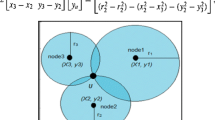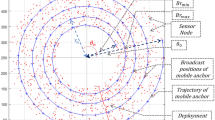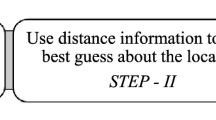Abstract
This paper presents a resilient localization scheme for wireless sensor networks (WSNs). It suits well in estimation of node position under a corrupted radio environment. Position computation is based on information of angle-of-arrivals (AoA) and references obtained from a few mobile anchors. In the network, anchors are equipped with smart antennas and global positioning system receivers. They broadcast signals in a synchronous and periodic fashion. The neighboring nodes having the signals with received signal strength values above a prescribed threshold level, respond with their respective IDs. Anchors evaluate AoA information from these signals using estimation of signal parameters via rotational invariance technique (ESPRIT) algorithm. Next, they forward beacon messages, containing their references and estimated angles, to the corresponding nodes and move along random trajectories. After receiving three sets of such data, at least, nodes can initiate selective segregation of the inconsistent position estimations. Simulation results attaining higher degree of localization accuracy validate its competency over the existing schemes.










Similar content being viewed by others
References
Boukerche, A., Oliveira, H. A. B. F., Nakamura, E. F., & Loureiro, A. A. F. (2008). Secure localization algorithms for wireless sensor networks. IEEE Communications Magazine, 46(4), 96–101.
Boukerche, A., Oliveira, H. A. B. F., Nakamura, E. F., & Loureiro, A. A. F. (2007). Localization systems for wireless sensor networks. Wireless Communications, 14(6), 6–12.
Gezici, S., Tian, Z., Giannakis, G. B., Kobayashi, H., Molisch, A. F., Poor, H. V., et al. (2005). Localization via ultra wideband radios: a look at positioning aspects of future sensor networks. IEEE Signal Processing Magazine, 22(4), 70–84.
Mi, Q., Stankovic, J. A., & Stoleru, R. (2012). Practical and secure localization and key distribution for wireless sensor networks. Ad Hoc Networks, 10(6), 946–961.
Garg, R., Varna, A. L., & Wu, M. (2012). An efficient gradient descent approach to secure localization in resource constrained wireless sensor networks. IEEE Transactions on Information Forensics and Security, 7(2), 717–730.
Jiang, J., Han, G., Zhu, C., Dong, Y., & Zhang, N. (2011). Secure localization in wireless sensor networks: a survey. Journal of Communications, 6(6), 460–470.
Srinivasan, A. & Wu, J. (2007) A survey on secure localization in wireless sensor networks. In: Encyclopedia of wireless and mobile communications, CRC Press, Taylor and Francis Group, Boca Raton, FL, USA, 2007, pp. 1–26
Biswas, R. N., Mitra, S. K., & Naskar, M. K. (2019). Preserving security of mobile anchors against physical layer attacks: a resilient scheme for wireless node localization. In M. T. Banday (Ed.), Cryptographic security solutions for the internet of things (pp. 250–282). Hershey, PA: IGI Global.
Jadliwala, M., Zhong, S., Upadhyaya, S. J., Qiao, C., & Hubaux, J. P. (2010). Secure distance-based localization in the presence of cheating beacon nodes. IEEE Transactions on Mobile Computing, 9(6), 810–823.
Biswas, R. N., Mitra, S. K., & Naskar, M. K. (2014). A robust mobile anchor based localization technique for wireless sensor networks using smart antenna. International Journal of Ad-Hoc and Ubiquitous Computing, 15(1/2/3), 23–37.
Gross, F. B. (2005). Smart antennas for wireless communications. New York: McGraw-Hill.
Liu, D., Ning, P., Liu, A., Wang, C., & Du, W. K. (2008). Attack-resistant location estimation in wireless sensor networks. ACM Transaction on Information Systems Security, 11(4), 1–39.
Zhu, W. T., Xiang, Y., Zhou, J., Deng, R. H., & Bao, F. (2011). Secure localization with attack detection in wireless sensor networks. International Journal of Information Security, 10(3), 155–171.
Han, G., Jiang, J., Shu, L., Guizani, M., & Nishio, S. (2013). A two-step secure localization for wireless sensor networks. The Computer Journal, 56(10), 1154–1166.
Jokhio, S. H., Jokhio, I. A., & Kemp, A. H. (2012). Node capture attack detection and defence in wireless sensor networks. IET Wireless Sensors System, 2(3), 161–169.
Ho, J.-W., Wright, M., & Das, S. K. (2012). Distributed detection of mobile malicious node attacks in wireless sensor networks. Ad Hoc Networks, 10(3), 512–523.
Du, W., Fang, L., & Ning, P. (2006). Lad: localization anomaly detection for wireless sensor networks. Journal on Parallel and Distributed Computing, 66(7), 874–886.
Prieto, J., Mazuelas, S., Bahillo, A., Fernandez, P., Lorenzo, R. M., & Abril, E. J. (2012). Adaptive data fusion for wireless localization in harsh environments. IEEE Transactions on Signal Processing, 60(4), 1585–1596.
He, D., Cui, L., Huang, H., & Ma, M. (2009). Design and verification of enhanced secure localization scheme in wireless sensor networks. IEEE Transactions on Parallel and Distributed Systems, 20(7), 1050–1058.
Lazos, L., & Poovendran, R. (2005). SeRLoc: robust localization for wireless sensor networks. ACM Transactions on Sensor Networks, 1(1), 73–100.
Lazos, L., & Poovendran, R. (2006). HiRLoc: high-resolution robust localization for wireless sensor networks. IEEE Journal on Selected Areas in Communications, 24(2), 233–246.
Capkun, S., & Hubaux, J. P. (2006). Secure positioning in wireless networks. IEEE Journal on Selected Areas in Communications, 24(2), 221–232.
Roy, R., & Kailath, T. (1989). Esprit - estimation of signal parameters via rotational invariance techniques. IEEE Transactions on Acoustics, Speech, and Signal Processing, 37(7), 984–995.
Li, X., & Gotzez, H.-J. (2001). Ellipsoid, geoid, gravity, geodesy, and geophysics. Scientific Journal of Geophysics, 66(6), 1660–1668.
Biswas, R. N., Saha, A., Mitra, S. K., & Naskar, M. K. (2019). Realization of PSO-based adaptive beamforming algorithm for smart antennas. In S. K. Shandilya, S. Shandilya, & A. K. Nagar (Eds.), Advances in nature-inspired computing and applications (pp. 135–163). Switzerland: Springer.
Cooke, B. T., Julicher, J., & Curtis, K. (2014). Smoke detection using change in permittivity of capacitor air dielectric. United States Patent Application Publication, Pub. No.: US 2014/0035753 A1
Author information
Authors and Affiliations
Corresponding author
Additional information
Publisher's Note
Springer Nature remains neutral with regard to jurisdictional claims in published maps and institutional affiliations.
Rights and permissions
About this article
Cite this article
Biswas, R.N., Mitra, S.K. & Naskar, M.K. Wireless Node Localization under Hostile Radio Environment using Smart Antenna. Wireless Pers Commun 116, 1815–1836 (2021). https://doi.org/10.1007/s11277-020-07763-8
Published:
Issue Date:
DOI: https://doi.org/10.1007/s11277-020-07763-8




